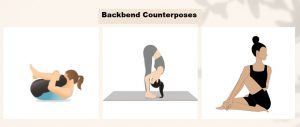How Yoga Improves Posture and Relieves Back Pain
For those of us spending endless hours at desks whether as students immersed in assignments or professionals glued to laptop screens, back pain and poor posture have become unwelcome companions. Prolonged sitting, insufficient movement, and slouched alignment all contribute to stiffness, discomfort, and a weakened spine. Yoga, especially backbends, offers a powerful antidote. By enhancing flexibility, strengthening muscles, and improving spinal mobility, backbends help combat the toll of a sedentary lifestyle. Let’s dive into the science-backed benefits of these poses and discover a lifeline for healthier posture and back relief.

How Backbends Benefit the Spine
📌 Restore Spinal Alignment and Boost Flexibility
Studies in the Journal of Bodywork and Movement Therapies reveal that backbends can help restore the spine’s natural curvature. They combat postural imbalances such as rounded shoulders and a hunched back by opening the chest and elongating the spine.
📌 Enhance Mobility and Joint Health
Backbends stretch and hydrate the intervertebral discs, keeping the spine mobile and reducing stiffness. This movement helps lower the risk of degenerative disc diseases.
📌 Build Back and Core Strength
A strong spine and core are vital for good posture and alleviating back pain. Research shows that backbends activate the erector spinae, glutes, and core muscles, providing better spinal support.
📌Alleviate Back Pain
Controlled backbends are recommended for reducing chronic lower back pain. According to The Spine Journal, regular extension movements can significantly improve lumbar function and reduce discomfort.
📌Boost Circulation and Energy Flow
By increasing blood flow to the spine and stimulating the nervous system, backbends help enhance focus, energy levels, and overall stress relief.
💡 Expert Insights
Here’s what professionals say about the transformative power of backbends:
💬 Yoga Instructor’s Perspective:
“Backbends are fantastic for reversing the effects of sitting. They strengthen the back, open the chest, and improve spinal health. However, correct technique is crucial to avoid injury.”
💬 Physiotherapist’s Opinion:
“Incorporating controlled backbends into your routine can work wonders for back pain relief. The focus should always be on engaging the core and distributing movement evenly across the spine.
⚠️ Avoiding Common Pitfalls
🚫 Mistake 1: Overarching the Lower Back
✅ Solution: Engage the core to evenly distribute the bend.
🚫 Mistake 2: Skipping Warm-ups
✅ Solution: Warm up with Cat-Cow, Cobra, and Child’s Pose before diving into deep backbends.
🚫 Mistake 3: Forgetting Counterposes
✅ Solution: Follow backbends with forward folds or spinal twists to restore balance.
🚫 Mistake 4: Holding the Breath
✅ Solution: Use deep, steady breaths to release tension and ease into the posture.

Key Takeaways
Here are some tips for a stronger back:
- 💪 Backbends restore spinal alignment and counteract postural imbalances.
- 🏋️ They strengthen the back and core muscles for stability.
- 📝 Research proves their effectiveness in reducing chronic back pain.
- 🚫 Practicing with proper technique prevents strain or injury.
- ⚖️ Warm-ups and counterposes are vital for a balanced practice.
Conclusion
Backbends are more than just yoga poses; they’re a pathway to a healthier spine, improved posture, and reduced back pain. Starting with gentle variations and practicing mindfulness ensures safe and effective progress. Ready to unlock your spine’s potential? Share your experiences with backbends and let’s inspire each other! 🩵
Previous post – Unlocking Strength and Flexibility: Beginner’s Guide to Yoga Backbends – Major Online Business and Marketing




Thanks Michelle, very helpful post🧘🏻♀️
Fixing my techniques
Hey Michelle, your yoga tips and tricks sounds great! I should think about it to take up again 🧘🏽♀️
Really interesting!
Great read on your Yoga Tips, I shall try it one day to gain more interest on it.